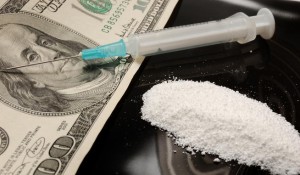By James A. Brown
Cities all across the country are facing an epidemic that not everyone is aware of. Heroin, a narcotic, is being sold in abundance all over the United States. The drug is known to be cut with other drugs such as floor cleaner and fentanyl making it even more dangerous for users. Frederick Police Chief Edward Hargis explained that some of the heroin coming off the streets has tested as high as 97% pure

The seriousness of the epidemic has been the primary concern for the Frederick Police Department. The heroin in Frederick is mostly linked to gang activity. Gangs are suspected to be the organizations selling heroin in mass amounts. MS-13 and Black Guerilla Family are two of many gangs operating in the Frederick area. When there are multiple gangs operating in similar areas, there is a chance of turf wars going on to protect the areas they are operating in. Heroin coupled with increasing gang activity has become a threat to public safety.
However, the distribution of heroin has been the primary matter of interest to the police. The state of Maryland has seen heroin overdoses increase by about 100 every year since 2010. In 2010, there were 238 deaths related to heroin. That number jumped to 578 throughout all of Maryland in 2015.
Although the state of Maryland has seen a dramatic increase in overdoses, Frederick has seen a drop since 2014. An opiate fighting nasal spray, Naloxone, is now being used to combat overdoses by Frederick police.
Chief Hargis said that already this year there have been nearly 40 overdoses. Of those 40 overdoses, 37 people were able to be saved due to Naloxone, better known as Narcan. Chief Hargis said “all of our officers have been trained to administer Narcan. It has been vital in our ability to combat overdoses.”
However, the introduction of Narcan potentially influences users to do more heroin knowing they have immediate options for treatment. Not everyone is fortunate enough to benefit from Narcan. Hargis explained that the epidemic has gotten so bad “you could be driving down the street, looked into a parked car, and see a dead person who OD’d.”

Chief Hargis has only been in his position since July of 2015 leaving him unable to comment on how overdoses were treated prior to Narcan. All officers are required to carry Narcan. Deputy Patrick Grossman said “we have 129 Frederick Police officers trained to identify opiate overdoses and administer Naloxone. The training hasn’t changed but could be modified in the future. Training modifications could be made to educate officers with new Naloxone applicators, medical protocol, and reporting requirements.”
Heroin users being treated with Narcan are typically addicted to other drugs prior to using heroin. It’s not uncommon for addicts to have previously been addicted to prescription pills. Vicodin, Xanax, and Percocet are known prescribed painkillers with addictive properties that have led to heroin abuse.
Once the medication is no longer prescribed, people turn to street drugs like heroin to avoid withdrawal symptoms. Withdrawal for all addicts is unbearable and typically includes cold sweats, vomiting, diarrhea, and seizures to name a few. Withdrawal sets in about 12 hours after the last dose of heroin was put into the body. After withdrawal is when users are most likely to overdose.
Common signs of an overdose entails deep breathing, decreased breathing, and skin losing its pigment. Depending on the potency and tolerance of the user, overdoses can set in anywhere from minutes to hours. The debilitating effects of withdrawal makes users want to take larger amounts of heroin to make them feel “normal” again.

Hargis explained the reason for the overdoses is the mindset of the users. Heroin addicts hear or read about overdoses and immediately go to the area where the overdose occurred to “score” heroin. The reason being that addicts believe that the person who overdosed was a beginning user. Addicts who have built a tolerance to the drug believe they have too high of a tolerance to experience the same fate.
Hargis and the Frederick Police are doing their best to combat the heroin epidemic with the resources they have available. The police budget was increase by approximately $900,000 for 2017 which will fund eight new vehicles and another K9 dog. Narcan has been essential to lowering overdoses and Chief Hargis hopes that it will continue to show positive results. Hargis said “to have 40 overdoses and rescue 37 people is considered a success and we will continue to fight this epidemic to the best of our abilities.”
Narcan training sessions are now available to the public. Sarah Drennan is responsible for coordinating trainings which are free of charge and come with one dose of Naloxone. The first training session was April 30th, 2014 and law enforcement training began in the middle of July the same year. Drennan said “word has gotten out and people know of its availability. We certainly have people jump on it immediately and people seek us out as they need to.” Trainings are done regularly and will be on the second Tuesday of each month at the health department located at 300B Scholls Lane Frederick, MD 21701.
For more information contact Sarah Drennan @ 301-600-1775 or SDrennan@FrederickCountyMD.gov